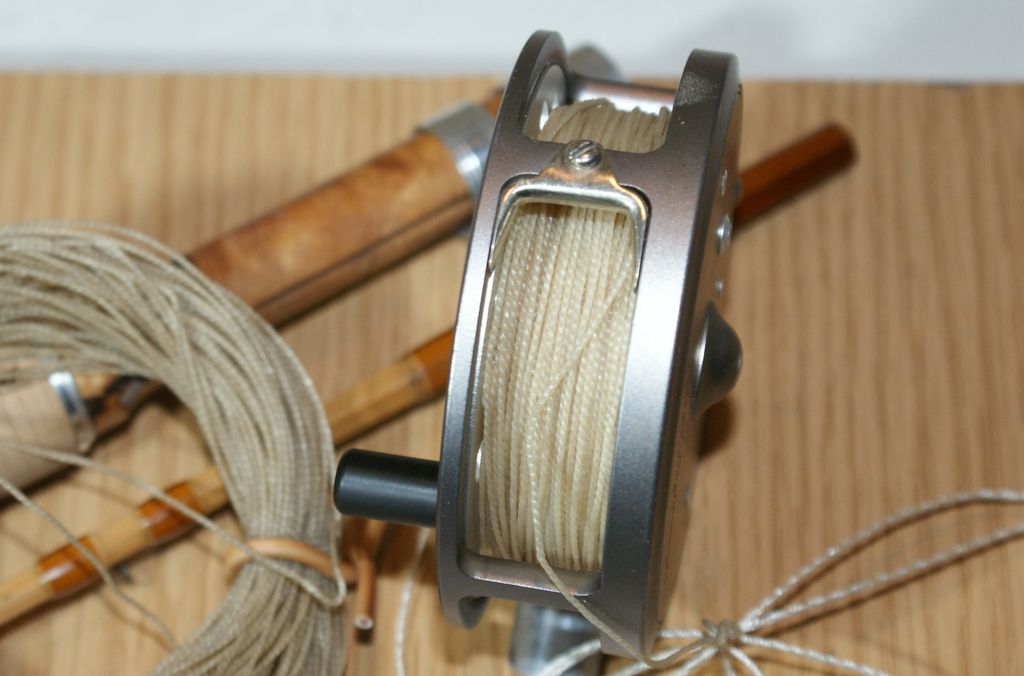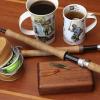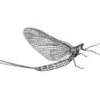
JEDWAB - nowe/stare linki, trendy...
#21
 OFFLINE
OFFLINE
Napisano 07 listopad 2012 - 21:29
#22
 OFFLINE
OFFLINE
Napisano 10 listopad 2012 - 16:51
#23
 OFFLINE
OFFLINE
Napisano 10 listopad 2012 - 19:41
#24
 OFFLINE
OFFLINE
Napisano 10 listopad 2012 - 19:41
#25
 OFFLINE
OFFLINE
Napisano 10 listopad 2012 - 19:56
PS. dodam jeszcze że powierzchnia linki już robi się taka jak w PCV, czyli śliska, nie czuć tej struktury jaka była od nowości
Użytkownik TomCast edytował ten post 10 listopad 2012 - 19:58
#26
 OFFLINE
OFFLINE
Napisano 13 listopad 2012 - 21:29
Silk Vs Plastic Lines
Casting and Line Splash, A practical Analysis
By Ralph Shuey
Two of the aspects of using silk lines vs synthetics with bamboo rods have always been the reputed ease of casting and the "stealth" capability of silk. My limited experience with the medium confirms these claims, and being an engineer I started looking for reasons behind these characteristics. Now you can look at these things objectively (hard facts), and subjectively (feel). I had experienced the subjective, the line felt easier to cast, and control; as well as it seemed to cause less 'commotion' when it landed on the water. I now wanted to confirm those observations and feelings with some real 'facts.'
For the uninitiated, there was a great revolution in fly line in the late 50's and early 60's with the advent of new synthetic floating lines. The period was very dynamic, with new materials and manufacturing processes seemingly being tried daily. In the end, not only did the materials and methods of manufacture change, but also more importantly, so did the line's size. The old lines that were made of woven/braided materials required "greasing" to float (thus the old term, "greased line technique"). The new synthetic lines trapped microscopic 'bubbles' in a plastic sheath to facilitate the same end. The new manufacturing technique was cheaper, and far easier to control, especially for mass production and required less care in the field. But the new technique came at a price. . .bulk.
Being good marketers the industry boys decided to put a good face on things and change the then existing system of line size designation. The old system was based on line diameter, so thus a silk line of diameter 0.045 inch was designated a C size (today's 6wt), a diameter of 0.035 inch was designated D size (5wt), 0.030 was E (4wt), and so forth. Industry "borrowed" a system in use in England at the time and converted from letters (A,B,C,D. . .) to numbers (1,2,3,4. . .) and tied the numeric system to line weight rather than diameter for the new synthetic lines. The new system required the first 30 ft of synthetic line to be the same weight as the old silk line designated as equivalent. And, as Reed Curry, a gentleman well versed in silk lines, so succulently put it: "Diameters were thus free to expand . . .and they did."
"So what's the big deal?" you ask? Simple. Two major aspects of line use, casting and presentation (i.e. line splash), are tied directly to line diameter. "Pardon me?" you say, "How so?" Well to exaggerate a bit to make my point. . .What could you throw further? A stone that weighs a half-pound, or a ball of cotton that weighs a half-pound? Obviously a stone. Why? Something that airplane/automobile/etc. designers call 'drag' which retards distance moved for the same effort expended. What would make a bigger splash? A half-pound steel ball or a half-pound wooden ball? The wooden ball; it's bigger! In this case the important function is 'displacement' (the amount of water moved). Mathematical equations describing both 'drag' and 'displacement' share a common factor. . .size. And in these cases, size is directly proportional to diameter, and in this case, size is known as 'area.'
Oh oh! "Things are starting to get hairy!" you claim? I'll try to keep it simple, trust me.
All of us know the equation for the area of a circle; pi (3.1416) times D (the diameter) squared (i.e. times itself) divided by 4 (or pi R squared). The thing that jumps out at you, as far as fly line is concerned, is that term D, diameter. "Isn't that the dimension the manufacturers of fly line let 'float,' you might ask. Yes, it is, and the horrible fact of the matter is, the effect of an increase in diameter is not linear (like a straight line) but exponential (a steep curve), because it is squared! Let me see if I can explain it simply.
The folks that manufacture silk line today (2 firms that I know of. . .) both agree that a silk line is on average 30% thinner than an 'equivalent' synthetic line. That 30% is very important to you the fly fisherman. A circle that is 30% greater in diameter than its supposedly equal companion has an area 69% greater in cross section! [Since all the other terms cancel out you only need to compare the effect of diameter [or radius] squared i.e. (1.3 x 1.3) - (1 x 1)/100 = 1.69 - 1/100 = .69]. That means 69% greater drag, or 69% greater splash between a silk 6wt line and an 'equivalent' synthetic line.
That means up to 69% less effort to cast a silk line a given distance, or, that means that a silk 6wt hits the water like a synthetic 4wt (roughly equal diameters)! WOW! So objective numbers confirm my subjective experience fishing silk fly lines vs. synthetic lines with a bamboo rod. There is a real reason that silk line "feels" so good. That distinct difference in drag, is why we, the bamboo/silk community, cast with a subtle wrist action. Whereas, the synthetic/graphite folks, must practice a full arm "high line-speed" school of casting. Also this may explain why rods cast so differently with silk vs. synthetic line. You literally 'load' the rod differently with a 6wt silk and a 6wt synthetic. (And now you have the reason those Orvis bamboo rods marked GBG or GBF are commonly used with 6wt synthetic lines.)
We in the bamboo rod community, have long recognized that a dearth of lightweight vintage production rods is available. Here is one of the reasons. With 69% less splash yesterday's silk 6wt could fish as quietly as today's synthetic 4wt. Thus, there probably wasn't much call for 4wts (About the same proportionate number as 2wts in use today?). This may also help explain why 7/8wt rods were proportionately more popular in the old days. An old 8wt silk would splash and cast about like today's 6wt synthetic and yet give you more beef and reach for those big bass and pike as well as the occasional salmon or steelhead.
So numbers confirm, "feel" and also answer some old questions. The old silk lines tended to cast and present better than their supposed synthetic equivalent because of smaller line diameter. But, of course, this analysis opens up some new questions as well:
(2.) How did the old time builders compensate for the new lines and when did they start?
(3.) Is there a true correction factor one can apply to determine which synthetic line to use on an older bamboo rod?
(4.) What are the optimum casting methods for bamboo rods/synthetic line and graphite rods/silk line?
(1.) How much compensation was made by the old manufacturers (in tapers) to accommodate the new lines?
All these questions and more beg answers. ~ Ralph Shuey
źródło:
http://www.flyanglersonline.com
#27
 OFFLINE
OFFLINE
Napisano 12 luty 2015 - 19:34
Odswieżam temat . Czy ktos ma jakies nowe doswiadczenia z tymi linkami . Dzieki za ewentualne uwagi ![]()
#28
 OFFLINE
OFFLINE
Napisano 12 marzec 2016 - 23:19
Jedwab własnym przemysłem.
Sznur cylindryczny, skręcany z nici jedwabnych, impregnowany próżniowo. Impregnat na bazie miksu oleju lnianego, tungowego i sykatyw.
- Paweł Bugajski, Fatso, ark70 i 3 innych osób lubią to
#29
 OFFLINE
OFFLINE
Napisano 13 marzec 2016 - 00:52
w morde jeża! Ciskałbym! Masz na sprzedaż to próżniowo olejowane cudo w #4??
Użytkownik teethar edytował ten post 13 marzec 2016 - 00:52
#30
 ONLINE
ONLINE
Napisano 13 marzec 2016 - 11:06
Opisze jak jutro po testuje
Musze Wam dawkować żebyście mi zawalu nie dostali
PS. dodam jeszcze że powierzchnia linki już robi się taka jak w PCV, czyli śliska, nie czuć tej struktury jaka była od nowościzaczyna i się coraz bardziej podobać
Tomek kiedy te jutro .?
- Paweł Bugajski lubi to
#31
 OFFLINE
OFFLINE
Napisano 14 marzec 2016 - 15:49
Cześć Jacku. Niestety linki dawno już nie mam. Dlaczego? Przestawiłem się na wędki w wyższej klasie, więc linkę sprzedałem razem z wędką, a nie miałem kasy żeby kupić nową :/ Co mogę powiedzieć o tamtej. Do suchej rewelacja, kładzie się delikatnie, zupełnie inaczej niż linki z pcv. Cienkość pozwala łowić w czasie nawet sporego wiatru, łatwiej się przebija w powietrzu. Nie jest tak podatna na podmuchy. Chyba jedyną wadą, chociaż to nie wada, ale jest trochę uciążliwe, to to, że po łowieniu trzeba dany odcinek linki rozłożyć do wyschnięcia i później nasmarować. Nowa linka jest bardzo sztywna. Trochę czasu zajmuje jej zmiękczenie, ale z upływem czasu łowienia, staję bardzo mięciutka. Jeśli tylko będę miał wolne środki to na 100% kupie sobie drugą ![]()
- Paweł Bugajski i Franc lubią to
#32
 ONLINE
ONLINE
Napisano 14 marzec 2016 - 16:03
Tomek
Bardzo dziękuje za informację .
Ja cały czas się waham.
Fajnie że się odezwałeś w temacie .
Mało bardzo rzetelnych informacji .
Jeszcze raz dzięki ![]()
- lajcik lubi to
#33
 OFFLINE
OFFLINE
Napisano 19 marzec 2016 - 21:12
A mnie kusi włoski handmade Terenzio Zandri..
http://www.terenzios...ouble-taper-dt/
http://classicflyrod...hp?f=65&t=39869
Użytkownik wild border river edytował ten post 19 marzec 2016 - 21:12
#34
 OFFLINE
OFFLINE
Napisano 19 marzec 2016 - 22:37
A mnie kusi włoski handmade Terenzio Zandri..
Nie dziwota, wagę linki można dobrać idealnie.
#35
 OFFLINE
OFFLINE
Napisano 20 marzec 2016 - 09:27
Swietna, rozmiarówka, róznorodny taper, to jedno, ale dodatkowo nowa linia "Revolution" z jedwabiu syntetycznego nie wymaga praktycznie żadnego smarowania.
http://www.terenzios...opo-revolution/
In generale, lo prendo! grazie per l'attenzione... ![]()
#36
 OFFLINE
OFFLINE
Napisano 20 marzec 2016 - 14:49
#37
 OFFLINE
OFFLINE
Napisano 21 marzec 2016 - 17:52
Jesli kogos to zainteresuje, dziele się poniższą informacja ktorą podeslal mi Terenzio...
I say to you that at this time i created a new artificial fly line:"Revolution" fly line.
The "Revolution" artificial silk fly line is innovative combination I managed to get a mix of the best quality silk and plastic.
This is a yarn resistant that does not break with both hot and cold temperatures.
This line is highly resistant to UV rays and sea water.
The features that characterize it are: smoothness, firmness, buoyancy, elasticity and noise.
I have pleasure in making you a discounted price from € 155,00 to € 145,00 plus shipping costs which depend on the weight of the package and the country.
#38
 ONLINE
ONLINE
Napisano 27 marzec 2016 - 07:08
@wild border river
Czy w tej lince są użyte dwa materiały naturalny jedwab i sztuczny .? Tak mi translator przetłumaczył.
Czyli wynika z tego że też ja trzeba smarować ? Dobrze rozumiem ?
#39
 OFFLINE
OFFLINE
Napisano 28 marzec 2016 - 18:57
Drogi Franc-u, Juz śpieszę z odpowiedzią na nurtujące Cię watpliwości.
Org. wiadomosc od producenta przesłana listem elektronicznym do mnie osobiście :
the Revolution artificial silk fly line is a mix of positive characteristics of fly braided line and fly line plastic.
It's not built with plastic materials but it is built like my natural silk fly line that is, with a yarn interweaving.
This fly line is really very durable.
Regarding the grease, this fly line does not need to grease, using a thin film of grease only when its buoyancy no longer meets and with one stroke of grease the fly line will start again to float for many hours / days of fishing.
You can choose your most suitable profile and color that you prefer.
For other informations and questions I will be happy to help to you.
Tłumaczenie: Microsoft translator ( R) ![]()
Rewolucja sztuczny jedwab linii lot jest mieszanką pozytywne cechy mucha plecionka i linia lot z tworzyw sztucznych. Nie jest zbudowany z tworzyw sztucznych, ale to jest zbudowany jak mój naturalny jedwab mucha linia oznacza to, że z przeplatanie przędzy. Ta linia lot jest naprawdę bardzo trwałe. Dotyczące smaru, ta linia lot nie trzeba smar, przy użyciu cienką warstwę smaru, tylko wtedy, gdy już nie spotyka się jej pływalności i jednym pociągnięciem smar linii lot ponownie rozpocznie się unosić przez wiele godzin / dni połowowych. Możesz wybrać swój najbardziej odpowiedni profil i kolor, który wolisz. Inne informacje i pytania chętnie pomogą Ci.
- Franc lubi to
#40
 OFFLINE
OFFLINE
Napisano 29 marzec 2016 - 07:58
Czyli jednak trzeba smarować ;P






















